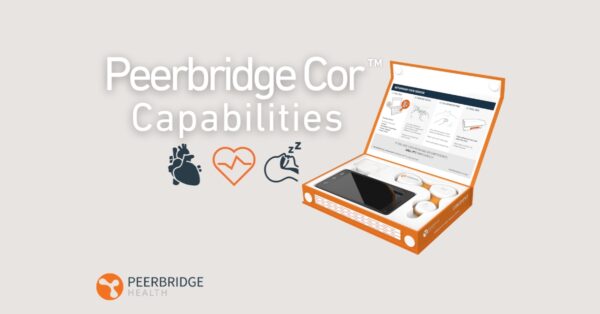Learn more about the importance of AFib burden and how it contributes to a more accurate picture of a patient’s AFib diagnosis and treatment.
Atrial fibrillation (AFib) affects up to 6.1 million adults each year, making it one of the most common rhythm disorders in the United States1. Research has shown that one of the most effective ways to screen for AFib is by wearing an ambulatory electrocardiogram (AECG), or extended Holter monitor, to monitor the heart’s rhythms continuously for several days. This allows physicians to not only diagnose a patient with AFib, but to also better understand their AFib burden – the amount of time the patient is in AFib out of the total monitored time. A higher AFib burden may indicate an increased risk of serious complications from AFib, like stroke, heart disease, and heart failure.
While many AECG devices report AFib burden, only the Peerbridge CorTM provides the most comprehensive clinical picture of a patient’s AFib beyond a global burden. Cor provides the detailed ECG data needed to identify suspected new onset AFib, manage patients with chronic AFib, and identify break-through AFib post-ablation.
Cor’s AFib/Flutter reporting starts with continuous, uninterrupted recording and analysis, providing a true burden percentage and specific breakdowns of how AFib presents within the patient, including:
- Global total AFib burden of monitored time,
- Daily AFib burden reporting,
- And, optimized diagnostic power and management of AFib by showing percentage that is Controlled AFib (60-100), Uncontrolled AFib >100, and AFib <60.

Understanding AFib burden is especially critical as the numbers continue to rise, with up to 12 million Americans expected to suffer from AFib by 20502. By taking a closer look at this important measurement, physicians can better recognize the severity of their patient’s condition, ensuring they receive the treatment they need quickly. Cor’s best-in-class AFib reporting helps support physicians as they diagnose and manage their patient’s AFib faster and more accurately – every time.
1Healthline. (2020). Retrieved from https://www.healthline.com/health/living-with-atrial-fibrillation/facts-statistics-infographic#Costs
2Lippi G, Sanchis-Gomar F, Cervellin G. Global epidemiology of atrial fibrillation: An increasing epidemic and public health challenge. International Journal of Stroke. 2021;16(2):217-221. doi:10.1177/1747493019897870




